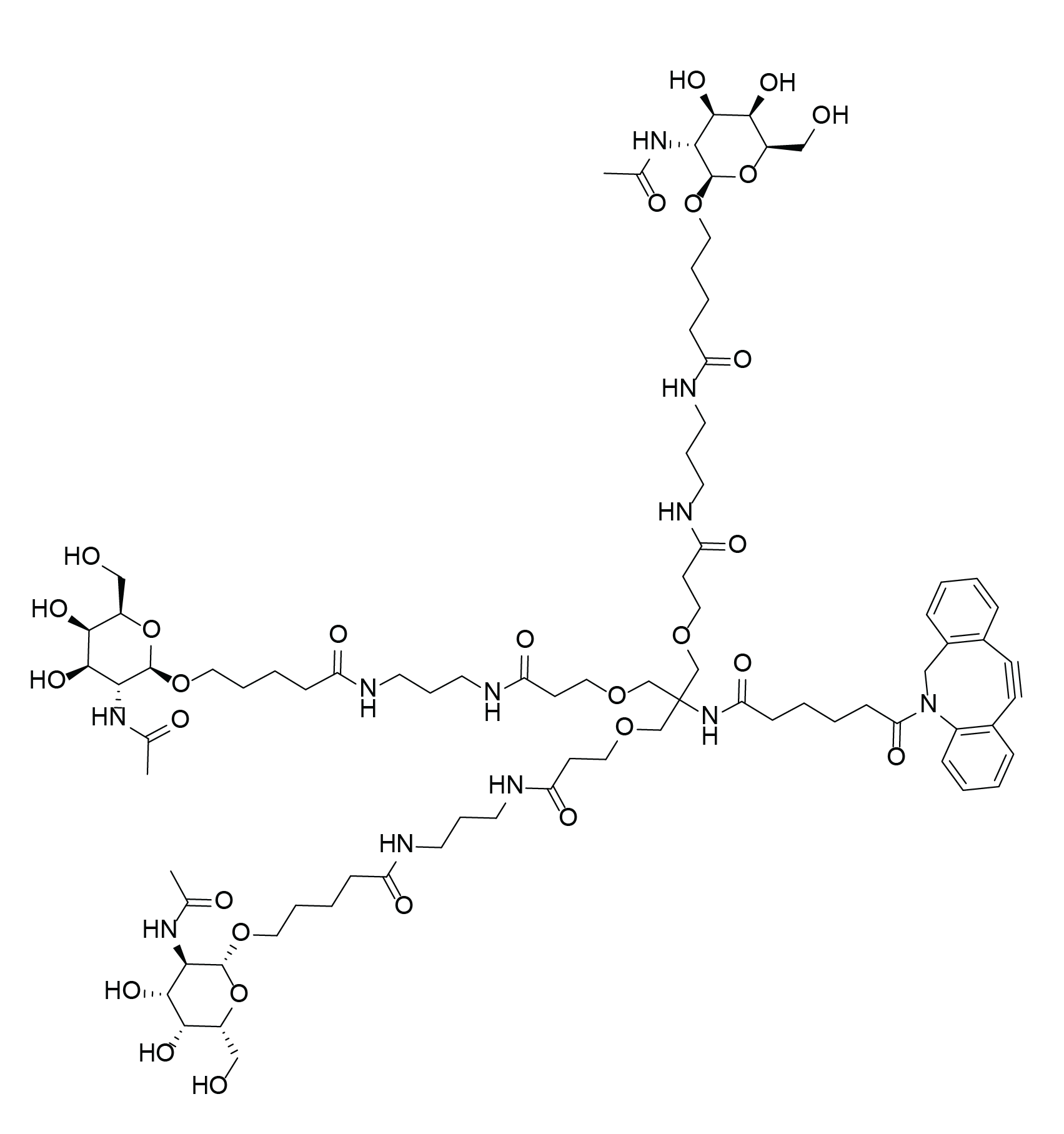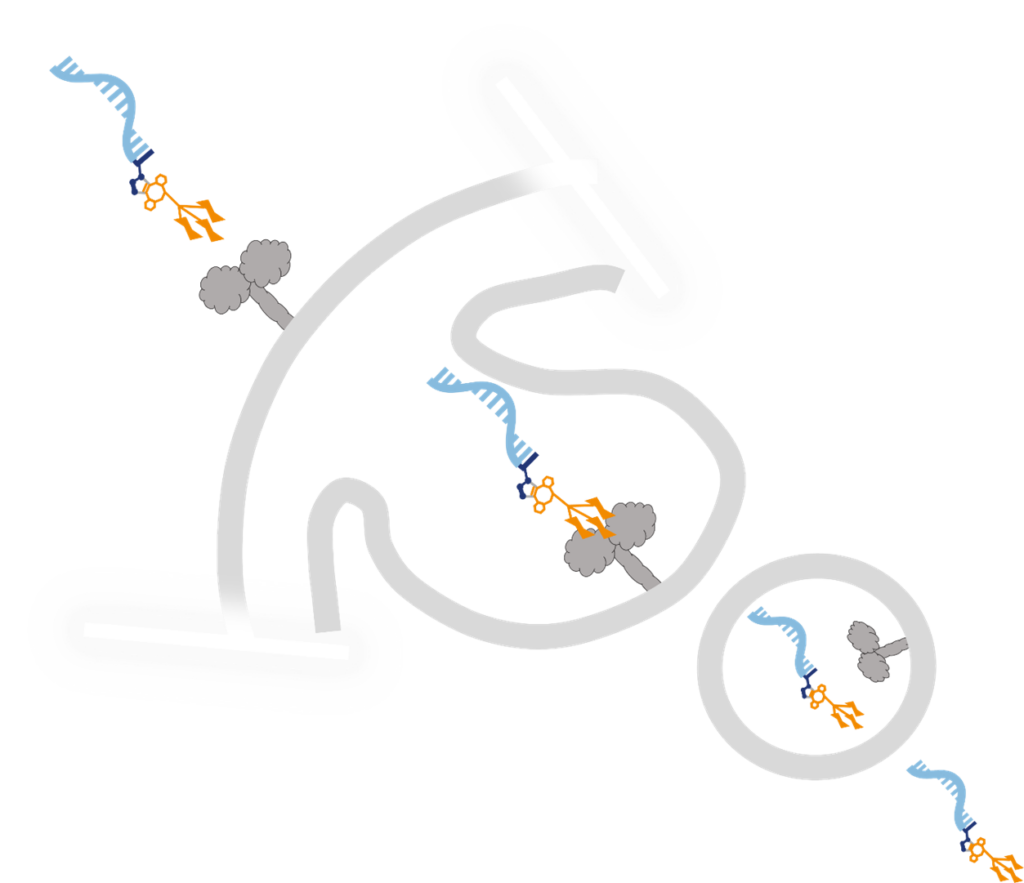Tri-GalNAc-DBCO
Copper-free clickable Tri-GalNAc identifier for target delivery

| Size | Catalog No. | Price |
|---|---|---|
| 5 mg | BCFA-245-5 | € 580,00 |
| 10 mg | BCFA-245-10 | € 990,00 |
Chemical Properties
-
Molecular Formula
C82H127N11O29
-
Shelf Life
12 months unopened after receipt
-
Storage Conditions
–20 °C, dark
-
Molecular Weight
1730.94 g/mol
-
Purity
≥ 98% (HPLC)
-
Physical State
white to off-white solid
-
CAS Number
n.a.
-
Solubility
H2O, DMSO
-
Preparation/Handling
For a 10 mM solution add 289 μL to 5 mg.
For a 10 mM solution add 578 μL to 10 mg.
Product Information
Tri-GalNAc-DBCO: Advanced Liver-Targeting Conjugation Reagent
Tri-GalNAc-DBCO is a synthetic molecule combining three N-acetylgalactosamine (GalNAc) residues with dibenzocyclooctyne (DBCO). This design enables high-affinity hepatocyte targeting via the asialoglycoprotein receptor (ASGPR) and bioorthogonal click chemistry through strain-promoted alkyne-azide cycloaddition (SPAAC). It allows efficient conjugation to azide-functionalized biomolecules such as nucleic acids, proteins, and therapeutic agents.

Why use Tri-GalNAc-DBCO for Liver-Specific Delivery
Conventional drug delivery systems often face challenges like low hepatocyte uptake, non-specific targeting, and limited RNA therapeutic efficiency. Tri-GalNAc-DBCO addresses these limitations by combining GalNAc-mediated receptor targeting with copper-free click chemistry, ensuring selective delivery and safe conjugation.
Key Features
- Trivalent GalNAc structure for strong ASGPR binding
- DBCO functionality for copper-free SPAAC click chemistry
- Bioorthogonal and catalyst-free for in vivo compatibility
- High purity and stability for reproducible results

Applications
Tri-GalNAc-DBCO has several practical applications, particularly in bioconjugation and targeted protein degradation:
- siRNA and RNA Therapeutics: Improves delivery for RNA interference and gene silencing
- Protein and Antibody Conjugation: Enables liver-specific delivery of biologics
- Targeted Prodrug Development: Supports controlled activation in hepatocytes
- Extracellular Protein Degradation: Facilitates LYTAC and targeted protein degradation strategies
- Bioconjugation via Click Chemistry: Enables precise, catalyst-free conjugation for research and drug development
How It Works
Tri-GalNAc-DBCO leverages ASGPR-mediated endocytosis for selective hepatocyte uptake, reducing off-target effects and improving therapeutic efficiency. Its DBCO group enables copper-free click chemistry, making it suitable for sensitive biological systems and scalable drug development.
baseclick: Your Partner for GalNAc-siRNA Conjugates
In addition to Tri-GalNAc-DBCO, baseclick offers custom GalNAc-siRNA conjugation services with exceptional purity and scalability, supporting preclinical research and therapeutic development.
LITERATURE
Site-Selective LYTACs for Targeted Protein Degradation, D. Trauner et al., 2021, Synfacts, Vol. 17(07), 0818.
https://doi.org/10.1055/s-0040-1719647
LYTACs that engage the asialoglycoprotein receptor for targeted protein degradation, G. Ahn et al., 2021, Nature Chemical Biology, Vol. 17(9), p. 937-946.
https://doi.org/10.1038/s41589-021-00770-1
Targeting the Epidermal Growth Factor Receptor with Molecular Degraders: State-of-the-Art and Future Opportunities, P. Maity et al., 2023, Journal of Medicinal Chemistry, Vol. 66(5), p. 3135-3172.
https://doi.org/10.1021/acs.jmedchem.2c01242
Targeted Strategies for Degradation of Key Transmembrane Proteins in Cancer, V. Sakanyan et al., 2023, Biotech, Vol.12, p. 57.
https://pubmed.ncbi.nlm.nih.gov/37754201/
FAQ
-
What is Tri-GalNAc-DBCO used for?
It is used for liver-targeted drug delivery, enabling conjugation of siRNAs, oligonucleotides, and proteins for hepatocyte-specific uptake.
-
How does DBCO enable click chemistry?
DBCO supports strain-promoted azide-alkyne cycloaddition (SPAAC), a copper-free click reaction ideal for biological systems.
-
Why use GalNAc for liver targeting?
GalNAc binds to the asialoglycoprotein receptor (ASGPR) on hepatocytes, ensuring selective uptake and improved therapeutic efficiency.
-
Is Tri-GalNAc-DBCO suitable for in vivo applications?
Yes, its copper-free click chemistry and high purity make it suitable for in vivo research.

